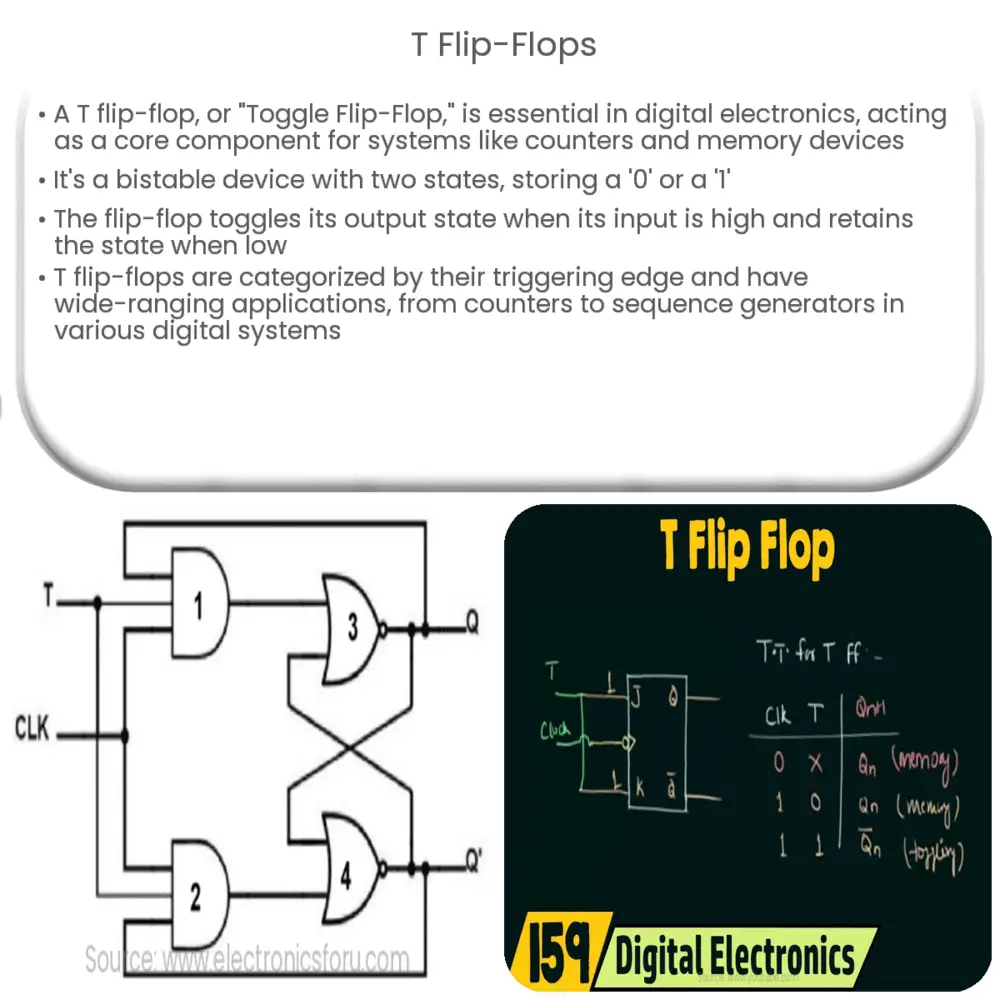Explore the fundamentals of T Flip-Flops, their components, functioning, types, and their wide-ranging applications in digital electronics.

Introduction to T Flip-Flops
A T flip-flop, also known as a “Toggle Flip-Flop,” is a fundamental component in the field of digital electronics. It plays a pivotal role in storing and processing binary data, acting as the building block for various digital systems such as counters, shift registers, and memory devices.
Functioning of a T Flip-Flop
Essentially, a T flip-flop is a bistable device, which means it has two stable states. It can store one bit of information, either a ‘0’ or a ‘1’. The ‘T’ in T flip-flop stands for “toggle,” which succinctly describes its behavior. When the input or ‘T’ is high (1), the flip-flop toggles its output state. Conversely, when the input is low (0), the output state remains unchanged.
Components of a T Flip-Flop
- Input T (Toggle): This is the control input of the flip-flop. Depending on its state, the flip-flop either changes or maintains its output.
- Output Q: This is the main output which reflects the current state of the flip-flop.
- Output Qbar: This is the inverse of the main output Q. If Q is high, Qbar is low, and vice versa.
- Clock Input: This input is used to synchronize the flip-flop’s operation with the rest of the digital circuit.
Types of T Flip-Flops
T flip-flops can be categorized based on their triggering edge: positive-edge triggered or negative-edge triggered. A positive-edge triggered T flip-flop changes its state with the rising edge (0 to 1 transition) of the clock pulse, whereas a negative-edge triggered T flip-flop changes its state with the falling edge (1 to 0 transition) of the clock pulse.
Usage of T Flip-Flops
With their unique toggling feature, T flip-flops are widely used in various applications. They are a key component in digital counters, where they help to increment binary numbers. Furthermore, they are employed in digital systems for generating specific sequences and are also used in shift registers for moving binary data.
To understand the practical implementation of T flip-flops and their role in complex digital systems, it’s crucial to comprehend their working principles, which is covered in the following section.
Working Principle of T Flip-Flops
A T flip-flop can be constructed using various types of flip-flops such as JK flip-flops or D flip-flops, by modifying their inputs accordingly. In a T flip-flop, when the T input is ‘0’, both outputs Q and Qbar retain their previous state irrespective of the clock pulse. When the T input is ‘1’, the outputs Q and Qbar toggle their state at each clock pulse.
Truth Table and Timing Diagram
The behavior of a T flip-flop is better understood through its truth table and timing diagram. The truth table provides a summary of the output states for each possible combination of input states, while the timing diagram illustrates how the outputs change over time with respect to the clock pulse and input T.
- Truth Table: A T flip-flop’s truth table consists of three columns, one for the clock, another for the input T, and the final column for the output Q. It effectively communicates how the flip-flop reacts to changes in the T input and clock pulse.
- Timing Diagram: This diagram shows how the output Q changes with respect to time, given a sequence of clock pulses and input T values. It graphically illustrates the flip-flop’s reaction to changes in the clock and input T.
Real-world Applications
In addition to their role in counters and shift registers, T flip-flops are used in various real-world applications. For instance, they are employed in frequency dividers and in hardware design to reduce circuit complexity. Furthermore, T flip-flops are also used in sequence generators and as control circuits in hardware algorithms.
Conclusion
In the realm of digital electronics, T flip-flops are of paramount importance. With their distinctive toggling capability, they serve as versatile components in numerous digital systems. From storing a single bit of information to enabling complex operations like counting and sequence generation, their functionality is truly comprehensive. Despite their simplicity, T flip-flops have a wide range of applications, underpinning the functionality of many digital devices we use in our everyday lives. As we continue to advance in the digital age, the significance of these humble digital components can only increase.

